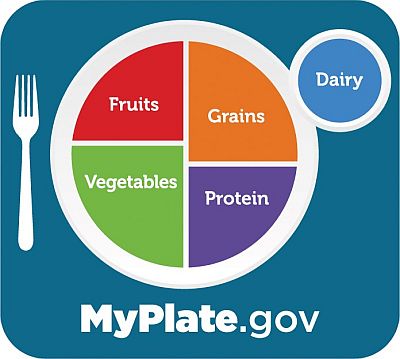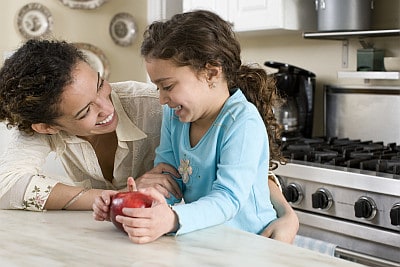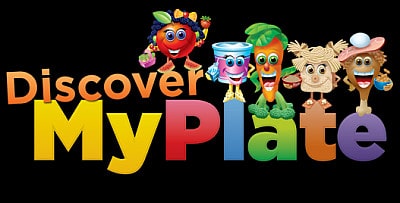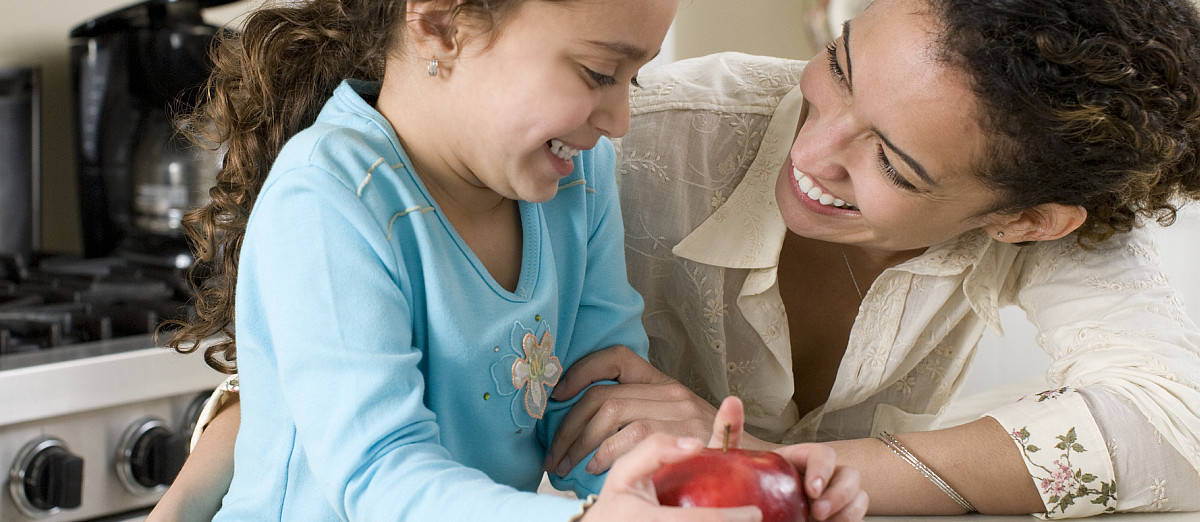Teaching kids about healthy eating habits is important. It’s hard to avoid the headlines that only about 10% of children are getting the amount of vegetables they’re supposed to eat. And news about childhood obesity and eating disorders gives parents other issues to be concerned about. So, while talking to your kids about food and nutrition is more important than ever, it’s also more challenging than ever.
As a parent, you don’t want every meal to turn into a lengthy lecture about food. But if you say nothing – or not enough– your child might pick up unhealthy eating habits that persist well into adulthood. In our digital age, kids are also being bombarded with information from a wide variety of sources, some of which aren’t at all accurate.

Karissa Zorn, RDN
Parents have an opportunity to make sure their children get factual, helpful information about food, nutrition and healthy eating habits that positively shape their long-term relationships with food, as well as their body image.
In this installment of our “What’s a Parent to Do” blog series, Chicago-based dietitian Karissa Zorn helps us better understand how and when to best talk to kids about nutrition and offers dos and don’ts to keep in mind as you talk to your kids.
“With social media, there’s a lot of good information out there, but also disinformation,” Karissa says. “Having a baseline of factual nutrition knowledge is important.”
Q: When should I start talking to my child about food and nutrition?
It’s good to talk to kids about food and nutrition at any age, says Karissa, and it’s never too early or too late to start. At the same time, you need to make sure the information you’re sharing is age appropriate.
For example, you can read picture books about fruits and vegetables to very young kids and sample foods with them. For elementary school age, you can be a little more sophisticated. Explain how green foods like broccoli help your body’s immune system fight off coughs and colds, or how a chicken breast will help you grow and help your muscles get stronger.
As kids get older, dive deeper into the science behind nutrition, the various vitamins and minerals that are naturally in the food we eat, and why they’re all important for a healthy body. For example, explain how spinach and kale are good sources of calcium and vitamins C and K and how these nutrients help the body.
Q: Is there a right way and a wrong way to talk to kids about food and nutrition?
 Young minds are molded so easily that you always want to give them a positive view of food, Karissa says. The most important lesson is that a balanced diet is key. There’s no one food that meets all our nutritional needs.
Young minds are molded so easily that you always want to give them a positive view of food, Karissa says. The most important lesson is that a balanced diet is key. There’s no one food that meets all our nutritional needs.
You can talk about the USDA’s My Plate five food groups as you eat meals together with your kids and explain how we need foods from various groups to stay healthy. To start, kids should know meals should have:
- A healthy starch or grain for energy;
- Fruits and veggies for all their plant-based nutrition;
- Protein to support healthy growth, and
- Calcium to help bones grow and stay strong.
You can talk about portion sizes, too. For example, for protein foods like meat, chicken, and fish, the palm of the child’s hand is usually appropriate. For starchy foods like rice, beans, and corn, the child’s cupped hand gives a reasonable serving. The child’s fist is a good portion size for cereal and fruit. Vegetable portions are a good option for filling up or second servings.
But Karissa reminds us that it’s normal for kids to choose not to eat their protein at one meal and to only eat carbs at another. Pushing kids to eat food they don’t want could make them rebellious and decide not to eat it at all.
As the Mayo Clinic Health System points out, “if parents push children to eat when they aren’t hungry, it could teach them to overeat by sending the message that they need to eat even when they aren’t hungry.
If parents limit how much food children eat during a meal, it can give children mixed messages and ultimately doesn’t allow them to listen to their bodies.”
Q: Is it OK to talk to my kids about “good foods and “bad foods?”
It’s best to avoid using words like “good” and “bad” when talking to kids about food. This can lead to kids having an unhealthy relationship with their food, sneaking food, and even future body issues.
Instead, use language that’s more neutral and accurate and teach that there’s room for all types of food in a healthy, balanced diet.
For example, call cookies “dessert” instead of “junk food.” No food should be off limits (barring any allergies). Instead, you want your kids to understand and internalize that some foods are not as nutrient-dense as others and should therefore be eaten less often.
Focus on kids trying new foods and talking about the foods’ base ingredients and components and what the foods provide for bodies. For example, with milk, there’s calcium for strong bones and also protein to help us grow and be strong, Karissa says.
Q: I’m not sure I know enough about healthy eating to talk to my child about it? Any tips?
 Parents don’t have to be nutrition experts themselves. You can follow their school’s lead and reinforce nutrition lessons from the classroom at home.
Parents don’t have to be nutrition experts themselves. You can follow their school’s lead and reinforce nutrition lessons from the classroom at home.
Ask your child what they learned about food in class or what they ate in the school cafeteria. At home, have them identify MyPlate foods on their dinner plate (There’s also a great MyPlate for younger kids as well).
Parents also have an opportunity to learn more about food and nutrition themselves.
There are plenty of helpful resources available, including online articles from reputable sources like healthcare systems, registered dietitians, and governmental agencies like the USDA. You can also check out books from your local library. Your child’s school or school district may have resources to help, too.
If you’re able to, having a session with a dietitian to talk about your family’s eating routines and what healthy habits look like can boost your knowledge. Your school’s dietitian may offer parent sessions where you can learn more.
Q: How can I talk to my kids about healthy eating without making a big deal of it?
“Make it fun,” Karissa says. “Talk about food while cooking or shopping at the grocery store.”
The best way to have kids absorb information about healthy eating is to make the conversations casual. You don’t want to seem like it’s a lecture or like it’s extra work or a chore to learn how to eat healthy. Bring up healthy eating and thoughts about food and nutrition naturally during family meals.
In the grocery store or at a farmers’ market, you can explain how different vegetables or fruit grow, where they come from, and the vitamins and minerals and other nutrients they provide. If your child enjoys watching cooking shows on television, that’s a great opportunity to talk about the ingredients cooks are using, too.
Q: What’s a Parent to Do? What are the top dos and don’ts when it comes to talking to kids about healthy eating?

Visit MyPlate for Kids for more ideas, tips, activities, and information.
As the saying goes, if you don’t walk the walk, you can’t talk the talk. Above all, you should model healthy habits yourself by eating a balanced diet. Karissa reminds us to keep discussions about health and wellness focused on healthy eating habits rather than slipping into talk about weight and connecting food to body appearance.
Other tips on how to best talk to your kids about healthy eating include:
Commit to family mealtime. Family meals eaten around a table are an ideal time to introduce thoughts on healthy eating. Don’t lecture kids though, make it fun and casual.
Read food labels together. When you’re at the grocery store or at home preparing meals, familiarize your kids with food labels and how to read them. It’s a good opportunity to explain to them what protein, carbs, and fiber are, for example, and how the body needs a balanced diet to be healthy.
Find other engaging resources. Your child might enjoy reading a cooking magazine or watching a cooking TV show or a kids’ cartoon that revolves around healthy food.
Talk with your pediatrician. Every visit to your child’s doctor is an opportunity to ask any questions you may have about nutritional health. Discuss specific questions or concerns about your child’s growth pattern and ask for suggestions on making positive changes in your family’s eating habits and activity levels.
If you’re concerned about your child’s weight: Check out a few additional suggestions at eatright.org (the website of the Academy of Nutrition and Dietetics), including important ideas like encouraging open dialogue, avoiding negative comments, avoiding the blame game, and seeking advice from a dietitian with a specialty in pediatrics.
Karissa Zorn is a Registered Dietitian and part of Aramark’s Nutrition Network—a community of dietitians within Aramark Student Nutrition. The Nutrition Network connects and engages Aramark Student Nutrition RDNs and other nutrition experts in ways that benefit school students, parents and caregivers, and their district’s health and wellbeing initiatives.
Note: Since everyone’s health history and nutritional needs are so different, please make sure that you talk with your doctor and a registered dietitian to get advice about the diet and exercise plan that‘s right for you.

